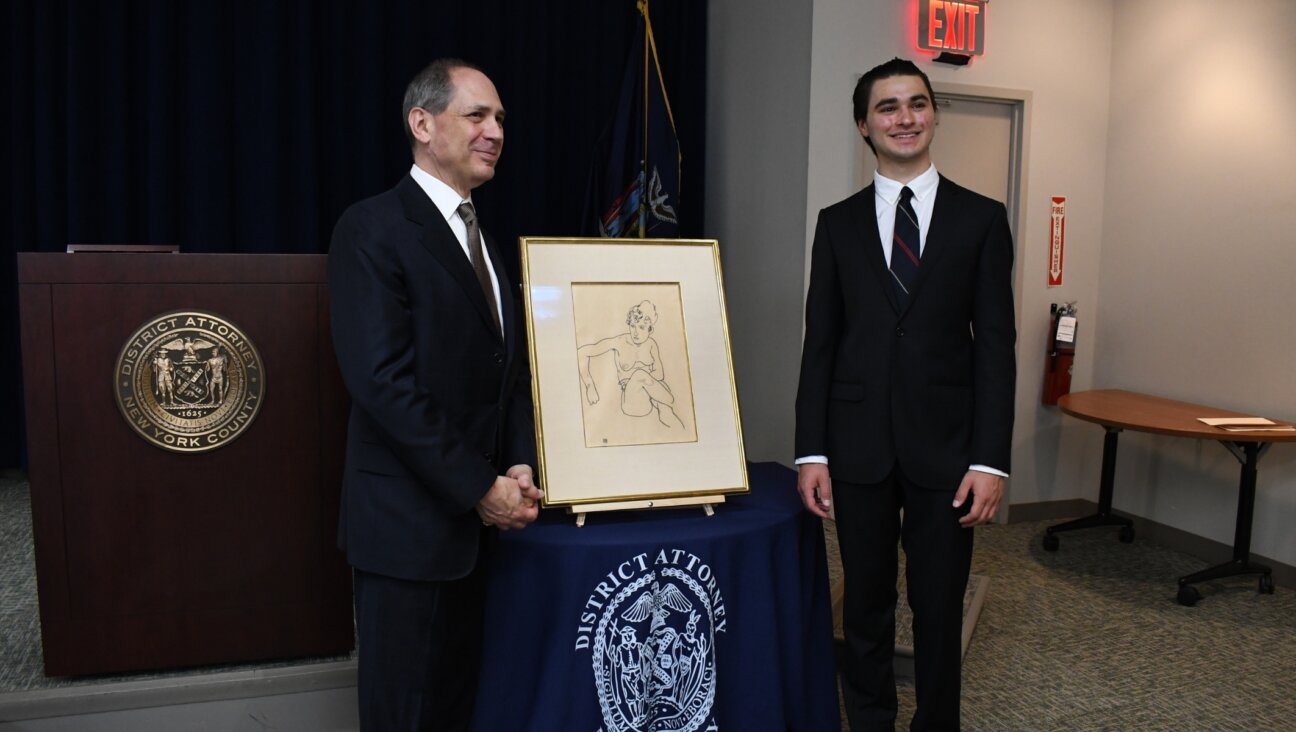Why Stanley Kubrick’s ‘2001’ is the ultimate golem story

2001: A Space Odyssey Image by Courtesy of Contemporary Jewish Museum
News that one of the iconic spacesuits from Stanley Kubrick’s “2001: A Space Odyssey” is going up for auction, gives us occasion to explore the link between the myth of the golem and Kubrick’s legendary science fiction film. The suit was made by the company P. Frankenstein & Sons Ltd. in Manchester, England, and the legend of Frankenstein is tied up with that of the Golem of Prague.
“The myth of the golem,” Yiddish novelist and Nobel Prize-winner, Isaac Bashevis Singer once wrote, “has interested so many creative people in the past and continues to do so even today in our epoch of science and technology.” Kubrick, who once consulted Singer about writing a Holocaust screenplay, was one of them.
The most famous legend of the golem was of the one created in Prague by rabbi and kabbalist Judah Loew (1525–1609). Created from clay, the golem comes to life when a piece of parchment is placed then removed from its mouth. The Golem of Prague directly inspired Mary Shelley’s 1818 novel “Frankenstein.” While the specifics of the settings and characters may differ, the stories share points of similarity. Dr. Frankenstein, like Rabbi Loew, sets out to create life from dead matter, only to lose control of his creation. Both stories end with the creature waging brutal violence on innocents.
From then on, the legend of the Golem and the story of Frankenstein became inextricably intertwined and it was through Shelley’s story that the myth of the golem began to enter wider, non-Jewish, popular culture.
Kubrick was no doubt familiar with both stories, and was certainly aware of the German expressionist films about the Golem. The Stanley Kubrick Archive holds material about Gustav Meyrink’s 1915 novel “The Golem.”
The legends of the Golem and Frankenstein can be seen in many of Kubrick’s films. Consider the title character of “Dr. Strangelove” or the android child in “A.I.: Artificial Intelligence” (started by Kubrick but completed by Spielberg in, aptly, 2001). Kubrick also included a clip from 1957 movie “The Curse of Frankenstein” in his film adaptation of “Lolita.”
But the legend also clearly underpins Kubrick’s “2001.” If a pragmatic use of Kabbalah is the creation of golems — powerful androids animated by the appropriate incantations consisting of mathematical permutations and combinations of the letters that made up various mystical names of God – then the animation of inert, inanimate objects by imputing the correct sequences of letters is precisely the task of computer scientists who can be seen, in practical terms, as modern Kabbalists.
This connection between computer programming and the use of Kabbalah to create automata was recognized when Gershom Scholem named the first computer in Israel “Golem.”
Hal 9000, the sentient supercomputer in “2001,” is the ultimate golem. Like the Golem of Prague and Frankenstein, HAL gains independence from his creators and murders the crew of The Discovery. When you rewatch the movie, pay attention to the precise moment that the scientists forget to remove the parchment from HAL’s “mouth” and lose control of their creation which subsequently goes on a killing spree.
HAL is revealed to be a murderous monster in precisely the same way as that in which the monster in James Whale’s classic 1931 movie, “Frankenstein,” is revealed.
Kubrick even consulted modern descendants of Rabbi Loew when making “2001.” Advisor Marvin Minsky (who came up with the name HAL) revealed in the late 1960s, at the same time as Kubrick was making “2001,” that his grandfather told him that he was a descendant of Rabbi Loew. Kubrick also met with Irving John “Jack,” Good, a statistician and mathematical genius who contributed to cracking the German Enigma codes during WWII. Good’s father, Moshe Oved, was also a Kabbalist.
And Kubrick had based the character Dr. Strangelove, in part, on Jewish nuclear strategist, John von Neumann, whom Scholem described as Rabbi Loew’s “spiritual ancestor” and who claimed he was a descendant of Loew.
If “2001: A Space Odyssey” is, in part, about the dangers of creating a golem/Frankenstein like monster, then it is apt that the movie premiered in New York City in 1968 at a theater called “Loew’s.”
A message from our editor-in-chief Jodi Rudoren

We're building on 127 years of independent journalism to help you develop deeper connections to what it means to be Jewish today.
With so much at stake for the Jewish people right now — war, rising antisemitism, a high-stakes U.S. presidential election — American Jews depend on the Forward's perspective, integrity and courage.
— Jodi Rudoren, Editor-in-Chief






















